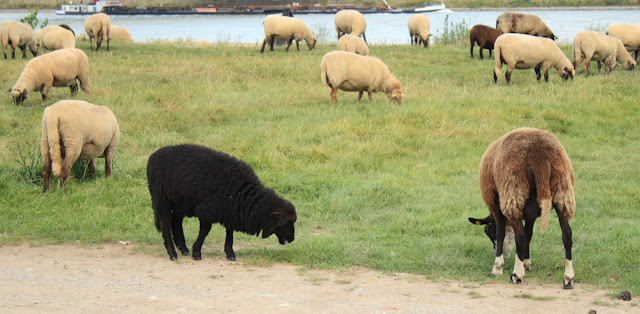( click on the pictures for a larger view in slide show and press Escape to go back to the blog )
Not far from the Rhine at the Brüggener Weg, 6 in Niederkassel, a suburb of Düsseldorf, the "Japanese Society for Buddhist Understand" has built the Ekô House together with a splendid Japanese garden , The garden is part of a Buddhist temple complex.
Outside in front of the garden , at the driveway leads up to the Ekô House , past the library and the Japanese Kindergarten, where German and Japanese children are taught together by a Japanese and a German teacher.
The temple gate ( 山門 ) at the entrance to the garden.
It has a beautiful wooden beam structure, covered by tiles.
At the end of the main pathway , a statue of Prince Shotoku (Shōtoku Taishi, 574-622), faces the entrance. Under his reign , he encouraged Buddhism to make its way into Japan.
The garden is laid out in a strolling garden style , whose main purpose is to let a visitor walk through it via several laid-out paths and enjoy the various views of the garden. The website calls it a 'Pure Earth" type of garden. It's used for ceremonies and concerts by the Eko House.
Several paths cross the garden, each offering different views. To the right a small gravel path leads away from the main path to the top of the garden , towards the Eko House and the Temple.
The gravel path leads past the wall of the garden to stepping stones that take you to a small lantern.
From the stepping stones you get a good look at the dry river bed and a lily pond. In the back you can see the magnificent bell tower.
A stone bridge with two arches takes you across the dry river to a central grass lawn.
On the bridge a view up the stream towards the top part of the path.
View from the double bridge towards the pond and the statue of the Prince.
On the central grass lawn you have a splendid view of the large Buddhist temple (claimed to be the largest of its kind in Europe ). The ground floor of the main hall of the temple is built like the Jōdo-shin Temple in Utsunomiya (north of Tōkyō).
On the central grass lawn , looking across to the bridge from the main path.
From the central lawn : view towards the bottom of the garden.
Walking back from the lawn and going up the path again, a glimpse of the Temple roof through the many Japanese maples across the dry river bed.
Further up, the path winds between massive rocks up to the top part of the garden and
ends in a stone staircase up to the Eko House.
Looking backward from up here , you can see the dry river bed flowing under the double bridge , and turn to the right towards a lily pond.
In the dry river bed I found this single flower.
The garden makes excellent use of hardy shrubs and maples and very few colourful plants. These Japanese lantern plants (Physalis) are just to the right of the entrance
The water basin at the left past the entrance , serves to purify yourself with water before entering the garden.
Just in front of the basin , to the left of the gate, a small path leads up a small rocky staircase to the bottom of the garden.
On the side of the path an small ornamental apple tree, bearing fruits.
The bottom of the garden contains a winding gravel path across a lawn lined with pines and a few hedges.
From up on the grass lawn at the bottom of the garden , you can enjoy views of the garden and pond below.
At the end of the winding path through the lawn , this delightful fountain hides between the shrubs .

Viewed from the main path ,the water pond lies quietly in the midday sun..
From the bridge , past some beautifully shaped pines , a view of the lily pond.
where the lilies are in bloom.
After crossing the bridge : glancing backwards to the left of the bridge , across the pond towards the entry gate.
From the main path : the bell tower.
The bell tower has a large bronze bell ,which is not just ornamental but used for ceremonies.
The wooden and tiled roof has beautiful ornaments.
Walking across the bridge from the central path you go towards the Temple.
Just like the roof of the bell-tower, the temple roof is ornamented.
View from the temple doors towards the garden.
The Wisteria on the pergola was no longer in bloom but I'm sure it smells wonderful
when it is.
From the path in front of the Temple , you get a good overview of the garden.
As I visited on a Wednesday afternoon, I was able to park in the underground garage , but I imagine it'll be pretty full during the weekend.
Despite the sunny weather , only about 8 people visited the garden during the 3 hours I spent there.
It's a pretty quiet place.
Visits to the Eko house are 2,5 Euros , but the garden is open to the public for free Tuesday till Sunday from 13-17h ( closed on Monday and during the Easter, autumn and Christmas holidays) , unless they're holding a concert or a ceremony there. So check the website of the Eko house
For professional photography ( ei weddings ) you need a permit.
There's another Japanese garden ( a pond garden ) in Düsseldorf , near the Dusseldorfer Messe , created by Iwaki Ishiguro and son, in the Nordpark ( 51°15'23"N 6°44'40"E ) which I hope to visit the next time I go over there.
























































